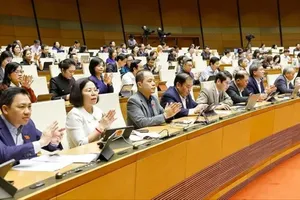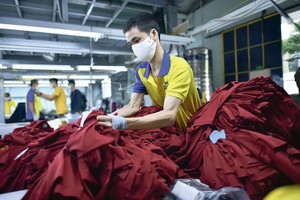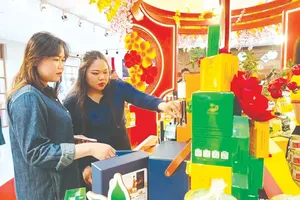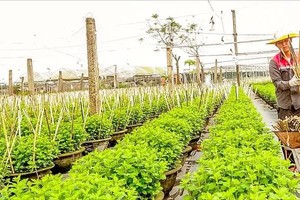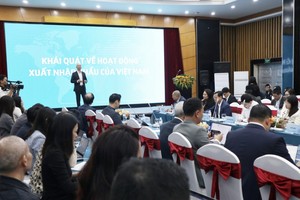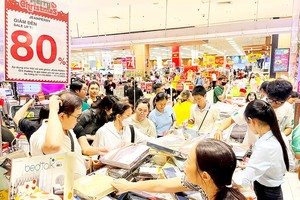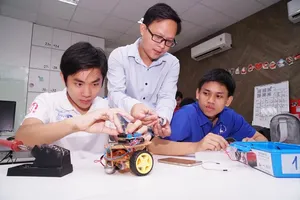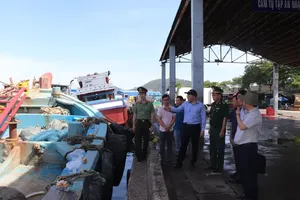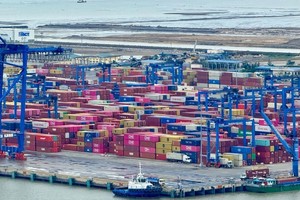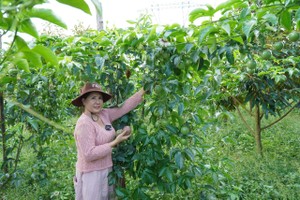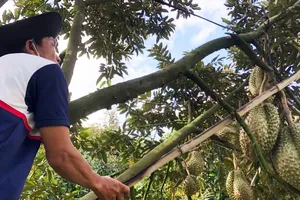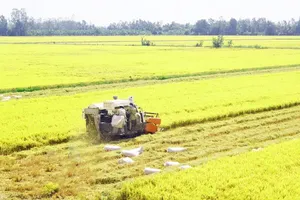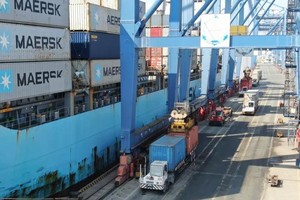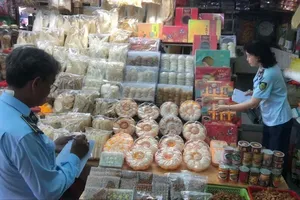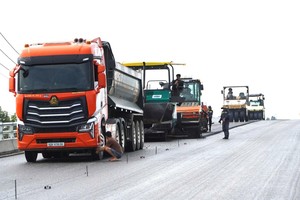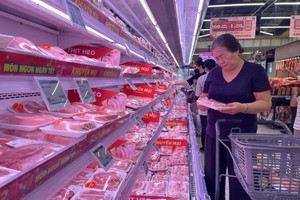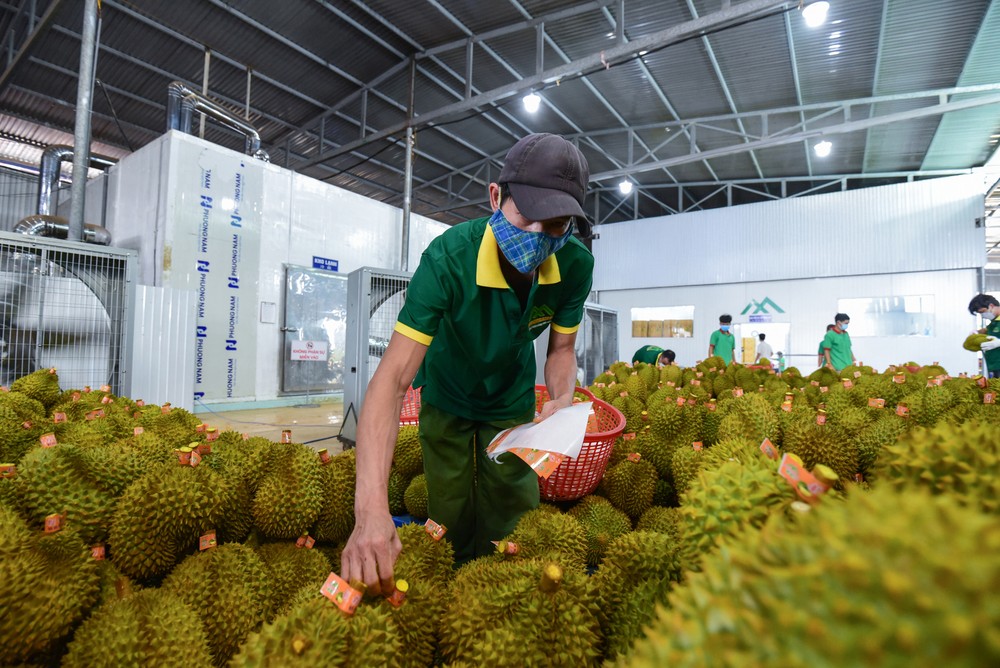
Export volume, prices declined significantly
In recent days, reports from Tien Giang Province and parts of the Dong Thap Muoi Region (Long An Province) show that traders are purchasing Thai Monthong durians for only VND130,000/kg and Ri6 durians for VND90,000/kg. Compared to just over two months ago, prices have fallen by VND30,000–40,000/kg, depending on the variety.
Nguyen Minh Long, a farmer in Long Trung Commune, Cai Lay District, Tien Giang Province, said his family has 1.2 hectares of durian trees that will be ready for harvest in about 1.5 months. "After hearing that China was tightening import conditions, my family reduced the use of pesticides and focused on improving fruit quality after Tet. However, with rising cultivation costs and continuously falling durian prices, which are expected to drop even further, I worry this durian crop will bring no profit—or even losses," he said.
Mr. Huynh Tan Loc, Director of Ngu Hiep Durian Cooperative (Tien Giang Province), said that many cooperative members have been deeply concerned about the sharp price drop over the past week. "All 10 hectares of our cooperative’s durian orchards follow VietGAP standards and are grown in designated planting zones. Beyond ensuring product quality, we are working closely with all stakeholders in the supply chain—from farmers to traders and exporters—to maintain stability and protect everyone’s interests," he said.
According to the Ministry of Agriculture and Rural Development (MARD), as of mid-February, Vietnam had exported only about 3,500 tons of durian to China, an 80 percent decline compared to the same period last year. This sharp drop follows China’s tightened quality control measures, particularly concerning residues of Auramine O, a banned substance detected in some shipments.
Vietnam's durian cultivation area has now expanded to 169,000 hectares—more than double the original target set for 2030. MARD has repeatedly warned about the risks of exceeding planned expansion since 2021-2022.
"Since early 2025, China has imposed stricter import controls on agricultural products, affecting not just Vietnam but all exporting countries. Durian shipments must be tested for cadmium and Auramine O in laboratories recognized by China, and every batch of Vietnamese durian is subject to 100 percent inspection before clearance. This is an emergency measure by China to protect consumer health," said Deputy Minister of Agriculture and Rural Development Phung Duc Tien.
Strengthening chemical residue control at the source
Mr. Vo Tan Loi, Chairman of Tien Giang Durian Association, said that in response to declining prices and export volumes, the association has urged the provincial People's Committee, the Department of Industry and Trade, and the Department of Agriculture and Rural Development to find solutions and support businesses in securing stable markets. Meanwhile, Mr. Vo Van Men, Director of the Tien Giang Cultivation and Plant Protection Sub-Department, stated that the province has tightened regulations on production and processing to ensure quality control from the source.
Mr. Luu Van Phi, Director of the Tien Giang Department of Industry and Trade, added that the department has strengthened quality management at every stage, from cultivation and intensive farming to harvesting, preliminary processing, and export packaging. Exporters have also been urged to complete Auramine O testing procedures at certified laboratories recognized by the importing country.
To address challenges in durian exports, MARD has expanded testing capacity to prevent bottlenecks caused by a lack of laboratories. Deputy Minister Hoang Trung stated that authorities have instructed specialized agencies to coordinate with law enforcement in strictly handling cases of falsified quarantine certificates and test results.
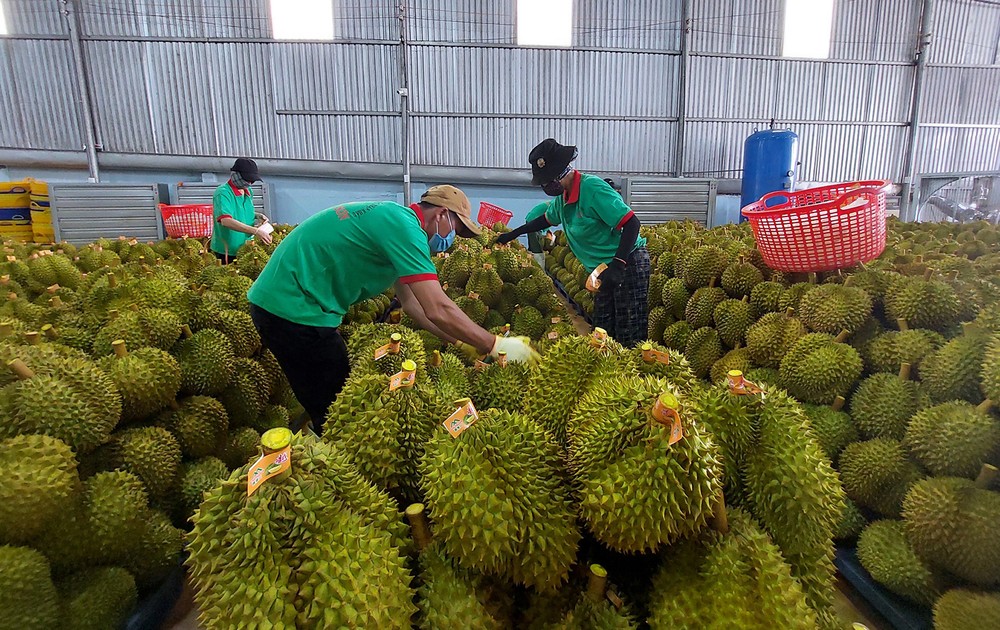
MARD is also enhancing cooperation with China’s General Administration of Customs to resolve violations quickly and prevent disruptions to the entire industry. In the long term, the ministry aims to restore durian exports under the bilateral protocol signed between the two countries, ensuring businesses are not burdened by additional measures. At the same time, a chemical residue monitoring program is being implemented across all durian-growing regions to ensure quality standards are met from the production stage.
Mr. Doan Thanh Son, Vice Chairman of the Lang Son Provincial People's Committee, noted that China has repeatedly warned about the need to improve agricultural product quality, but some Vietnamese traders have been slow to adapt. As a result, exports have faced challenges when shipments fail to meet the stricter standards in time.
Mr. Vo Huu Long, Director of Long Thuy Production and Trading Co., Ltd. (Bao Lam District, Lam Dong Province), highlighted that China has tightened import restrictions on durian with even lower thresholds for lead and cadmium residues. This has created significant difficulties for exporters, who must send samples to testing centers in Hanoi and Can Tho designated by Chinese authorities. "Even when shipments pass initial testing, some fail re-testing at the border, leaving exporters uncertain about how to proceed. This forces us to be more cautious, and with the upcoming peak harvest season in the Central Highlands, there is a real risk that thousands of tons of durian may not be exported," he said.
Ms. Nguyen Thi Ngoc Huong, Director of N&H Agricultural Products JSC (Dak Lak Province), stressed that meeting import standards requires collaboration between businesses, farmers, and regulatory agencies. "Durian growers must adhere to proper production practices, using only fertilizers and pesticides approved by authorities, while regulatory agencies need to provide clear technical guidance for farmers in designated growing areas," she said.
In 2024, Vietnam’s durian exports reached $3.4 billion, surpassing the record set in 2023 and contributing nearly half of the total fruit and vegetable export revenue, which exceeded $7.2 billion. However, in less than two months of 2025, the situation has reversed, with both export volume and revenue plummeting. By mid-February 2025, Vietnam had exported only 3,500 tons of durian, an 80 percent decline compared to the same period in 2024.
Several factors have contributed to this downturn. The most immediate impact comes from China’s stricter quarantine and food safety regulations, requiring 100 percent inspection of all durian shipments from Vietnam. Since January 10, China has also mandated certification proving that shipments are free from Auramine O, a potentially carcinogenic compound. These heightened requirements have extended customs clearance times, increasing the risk of spoilage for fresh fruit and forcing many exporters to redirect shipments to the domestic market.
Beyond regulatory hurdles, structural imbalances within the industry have exacerbated the crisis. Under Vietnam’s agricultural plan, the total durian cultivation area was projected to reach 75,000 hectares by 2030, but by 2024, it had already surpassed 160,000 hectares. This rapid expansion pushed production to 1.45 million tons in 2024—far exceeding market demand and export capacity. When China, Vietnam’s primary durian market, tightened import rules and reduced purchasing, the resulting surplus put immediate downward pressure on prices.
Over-reliance on a single market has made the industry highly vulnerable. China accounts for 95 percent of Vietnam’s total durian export revenue and is now enforcing stricter controls and traceability requirements. Without expanding into new export markets, Vietnam’s durian sector remains at risk whenever China adjusts its policies.
Another key issue is the lack of coordination in the supply chain. Most durian farms are small-scale household operations with fragmented production, lacking strong connections to enterprises and cooperatives. This weak linkage makes quality control and adherence to standardized farming practices more challenging. As prices drop, farmers face pressure to sell at lower rates, while exporters struggle to secure stable market access.
The "durian bubble" has emerged as farmers rapidly expand cultivation, often replacing traditional crops like oranges, tangerines, and even rice. This unchecked shift not only disrupts ecological balance but also carries significant economic risks if market conditions remain unstable. Many growers, lacking proper knowledge of sustainable farming and market trends, have rushed to increase planting areas, leading to oversupply. This not only threatens farmers' livelihoods but also jeopardizes the long-term stability of the durian industry.
To address these challenges and ensure sustainable growth, a coordinated approach is essential. The industry needs restructuring through strategic land-use planning, tighter control over cultivation areas, and a stronger focus on quality. Local authorities must review and issue planting area codes, enforce international-standard farming practices, and implement strict quality control measures from the outset. At the same time, reducing reliance on China by expanding into other export markets is crucial.
Businesses should actively explore high-potential markets such as South Korea, Japan, the EU, and the US, where demand for durian remains strong among Asian communities. While these markets impose stricter standards, they offer greater long-term stability, making Vietnam’s durian industry more resilient to external shocks. Investing in post-harvest preservation, strengthening supply chain linkages between farmers, cooperatives, and enterprises, and promoting deep-processing—such as frozen durian, confectionery, and functional foods—can enhance competitiveness and ease seasonal consumption pressures.
Meanwhile, authorities should develop policies, regulate the market, assist farmers and businesses in accessing market information, and promote sustainable farming practices, including organic production.
By Dr. Tran Huu Hiep – Translated by Thuy Doan

